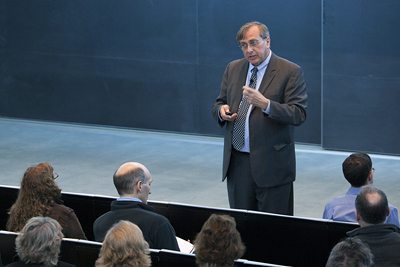Provost touts transparency of new budget model
By Nancy Doolittle

At the first of two public forums introducing the university's new budget model, Provost Kent Fuchs explained how the implementation of the model will help the university distribute revenues and address costs in ways that are consistent, coherent and transparent across the colleges and units.
The budget model is the result of three-and-a-half years of discussion, Fuchs told an audience that filled Milstein Hall auditorium Dec. 12. A second presentation, for those who could not attend the first, will be held Dec. 20, 10 a.m.-noon, in 251 Malott Hall.
Fuchs said that the model brings clarity to the university's financial status overall, helping focus discussions among the vice presidents, vice provosts and deans about how the university is spending its money. "It's really causing us as a community to think and make decisions collectively," he said.
Budget model panel discussions (see Events Calendar for locations and more information):
Jan. 8 - Utilities, Maintenance, Building Care, Debt Services, with Elmira Mangum, Maria Cimilluca and John Adams, 1-3 p.m.
Jan. 10 - Tuition, Enrollment, Financial Aid and State Appropriations, with Mangum, Barb Knuth, Marin Clarkberg and Rob Van Brunt, 1-3 p.m.
Jan. 17 - Allocated Costs, Libraries, University Support Pool (USP), with Mangum, Karen Pearson, Lee Cartmill and Rob Van Brunt, 2-4 p.m.
Jan. 24 - Facilities and Administrative Cost (F&A) and Research, with Mangum, Robert Burhman, Cathy Long and Davina Desnoe, 9-11 a.m.
Fuchs was quick to allay concerns that the new model would result in additional cuts to college and vice president budgets that start in July 2013. Instead, the allocations made and "taxes" levied against the colleges and units will initially mirror the budget totals the individual colleges would have had under the current model. The budget model is not meant to generate or deplete resources, he said; rather, it changes the processes by which resources and expenses are distributed across the university.
Revenues are generated through undergraduate and graduate tuition and fees; philanthropy and gifts to the university (some of which are restricted by the donor to particular areas); payout on the university's endowment; funds from New York state; and indirect costs covered by external grants. Currently, these revenues are generated and distributed through several budget models, depending on college or unit. The new model will replace these, pooling some revenues and expenses centrally and redistributing them out to the colleges and units based on various metrics.
Some revenues, such as graduate and professional tuition and fees, will go directly to their respective colleges, although professional tuition will be subject to the university tax at the same rate as undergraduate tuition. Similarly, the payout from endowed professorships will go to the college or unit of that professorship.
Undergraduate tuition, however, will be pooled and distributed. Some of these funds will be used to even out such current differences as in-state and out-of-state tuition. In addition some of the pooled funds will be placed into a University Support Pool that will be used for university initiatives and strategic goals.
The colleges and units will also be allocated the costs for central services used by all of campus, such as information technology support and the libraries; the amount of the allocated cost will be based on, for example, the respective college's or unit's number of faculty, students and staff.
Most tuition revenues will flow directly to the colleges and academic units, the amount determined according to a formula, to be applied to their own budgets, salaries and the operation of their facilities. Facilities operations and maintenance expenses will be distributed and paid by all units on a per-square-foot basis according to an average of these costs on each of five types of buildings across campus.
Revenue allocations to specific programs and departments within a college or unit will be made by their respective dean, vice provost or vice president.
The new model will also be used for the Cornell NYC Tech campus, Fuchs said, though that campus will maintain a self-sustaining budget, supported by its own revenues.
In response to a question about whether the new model could create disincentives or tensions between colleges and central units, Fuchs said that he believes it is more important that Cornell's leaders have a clear understanding of the university's finances and expenses. Doing things consistently, he said, "allows us to be able to compare and collectively discuss where we are making investments, where we are not making investments, where our resources are going."
"Cornell will be much better from a process perspective," he said.
Media Contact
Get Cornell news delivered right to your inbox.
Subscribe